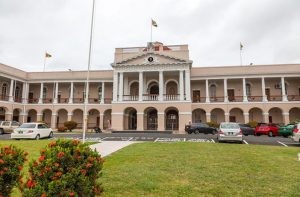West Indies Cricket Fans Forum
Move by government to restore City Hall to its former glory is a brilliant one
The Government of Guyana must be commended for its demonstrative and strong leadership in the restoration of the City Hall Building. Indeed, the tender issued for the restoration of City Hall, which appeared in yesterday’s Sunday Stabroek, is not only refreshingly good news but also a necessary and important governmental action that is particularly reflective of a certain deep historical and cultural sensitivity. Undoubtedly, this will go a far way in helping to preserve and promote our cultural heritage and boosting the local tourism industry.
Again, this is important because that building serves a vital role in accommodating municipal offices, services and facilities. It is central to many local communities and easily accessible to property owners, and citizens, who want to settle their accounts, make reports or seek information. Also, it leaves a visual legacy of the nation’s Capital. This iconic building, situate in the heart of Georgetown, was constructed in 1889. Since that time, no major works were done to any part of its structure. In 2011, the Government, through its Ministry of Public Works, under the then Minister, Mr. Robeson Benn gave about $40 Million dollars to the council to begin restoration of the building. That money was used to purchase windows, and to do minor repairs to the floor and the wall on the western side of the building. However, over those years, in the absence of a strict maintenance plan, the building deteriorated beyond the financial and technical competencies of the Council.
In 2013, under the Mayoralty of Mayor Hamilton Green, international consultants from a Grenadian company, Nigel Renwick and Ihosvany De Oca Morales along with local engineers including former acting City Engineer, Bert Carter did a condition analysis of the building. One of the consultants said that the building was suffering from “cardiac arrest”. As far as I can recall, that trip was funded by the private sector; consultation was free. That report is still within the archives of the council.

That, notwithstanding, in 2016, using its very limited financial and technical resources, the Council started major restorative and repair works to many of its buildings that were in an almost ruinous state including Kitty Market, the City Engineer, the Solid Waste Management and the City Constabulary Buildings. During that period, the Council also reached out to and leaned upon its relationship with the National Trust, the European Union and other organisations for help with the restoration of City Hall.
In that same year, the Delegation of the European Union signed a contract with EURONET Consulting GEIE for EUR 279, 196 ($64M) for a restoration, conservation study of City Hall and City Engineer Buildings. Two critical aspects of that assessment were the preparation of a comprehensive green restoration plan and an appropriate conservation management plan for City Hall Building. The assessment also included training of stakeholders and those, who would be responsible for its maintenance and care.
Unquestionably, City Hall is among the most outstanding architectural, cultural and historical buildings not only in Guyana but also in the Caribbean. It is a national landmark that deserves special attention from the authorities and in fact all of us. And government’s position, practical as it is, must not be taken lightly. It has huge national and international utility for the government itself, the national capital and Guyana.
This recent move by the government, to restore the City Hall to its former glory is a brilliant one. It will create a positive stir in the city, and improve the aesthetics of Georgetown. More importantly, I believe that, it would encourage local and international corporations, organisations, groups and individuals to participate, financial and otherwise, in a massive city undertaking rich in historical, cultural and architectural significance to the city.
Guyana Diaspora Forum
We have a large database of Guyanese worldwide. Most of our readers are in the USA, Canada, and the UK. Our Blog and Newsletter would not only carry articles and videos on Guyana, but also other articles on a wide range of subjects that may be of interest to our readers in over 200 countries, many of them non-Guyanese We hope that you like our selections.
It is estimated that over one million Guyanese, when counting their dependents, live outside of Guyana. This exceeds the population of Guyana, which is now about 750,000. Many left early in the 50’s and 60’s while others went with the next wave in the 70’s and 80’s. The latest wave left over the last 20 years. This outflow of Guyanese, therefore, covers some three generations. This outflow still continues today, where over 80 % of U.G. graduates now leave after graduating. We hope this changes, and soon.
Guyanese, like most others, try to keep their culture and pass it on to their children and grandchildren. The problem has been that many Guyanese have not looked back, or if they did it was only fleetingly. This means that the younger generations and those who left at an early age know very little about Guyana since many have not visited the country. Also, if they do get information about Guyana, it is usually negative and thus the cycle of non-interest is cultivated.
This Guyana Diaspora Online Forum , along with its monthly newsletter, aims at bringing Guyanese together to support positive news, increase travel and tourism in Guyana and, in general, foster the birth of a new Guyana, which has already begun notwithstanding the negative news that grabs the headlines. As the editor and manager of the publication, I am committed to delivering Blog entries and Newsletters that are politically balanced, and focused on the positive ideas we wish to share and foster among Guyanese.
| ||||

